Kraków 2020-02-15
140 Section 1956-05-25
WSK Mielec Lim-5
Poland
History
Fighter plane.
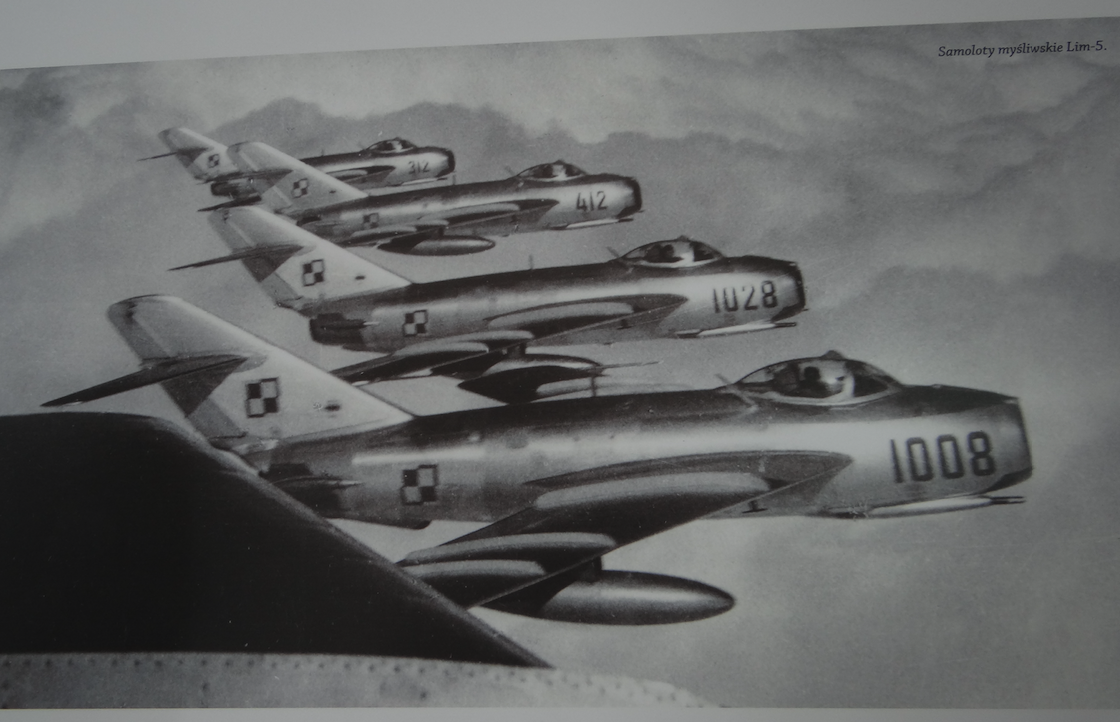
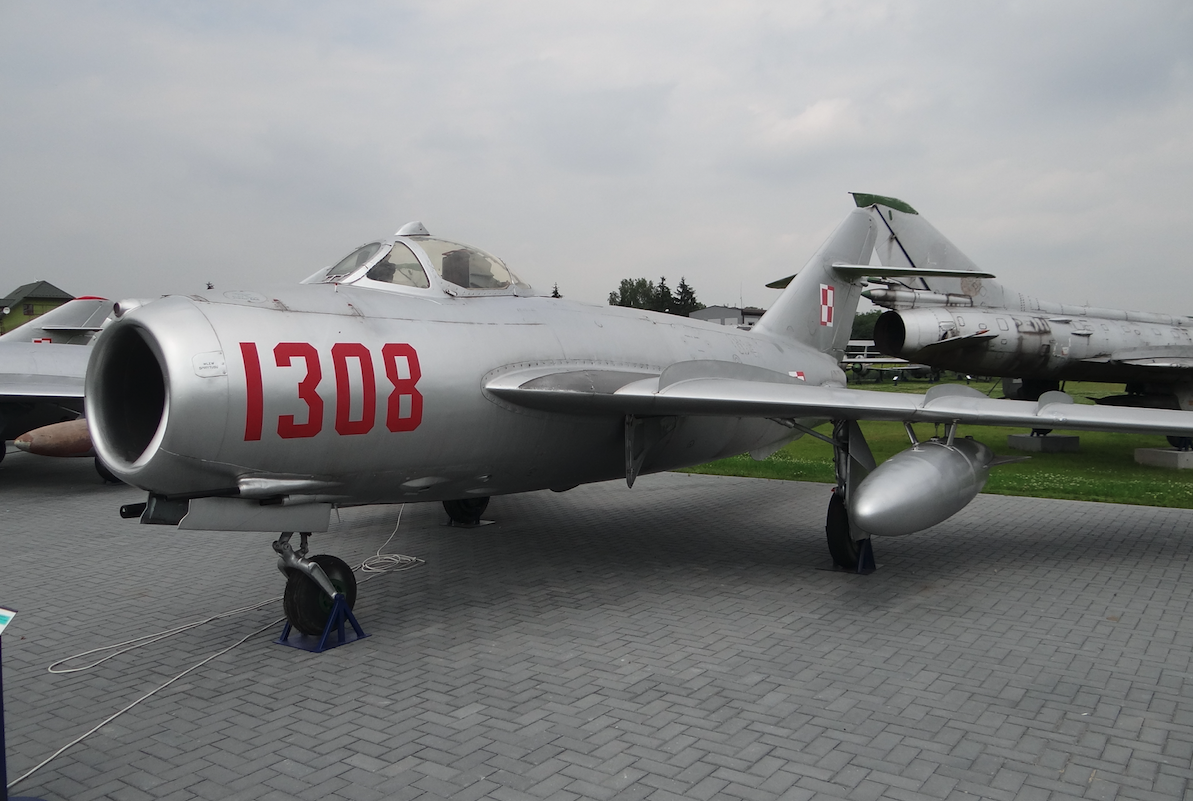

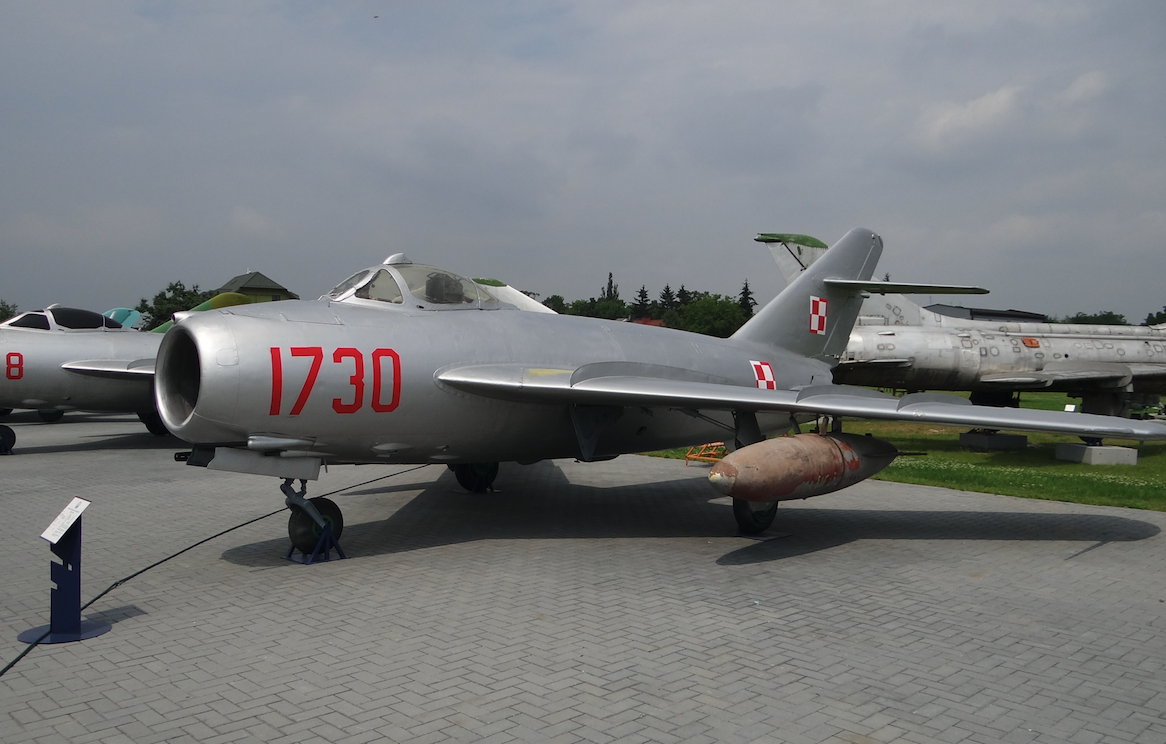
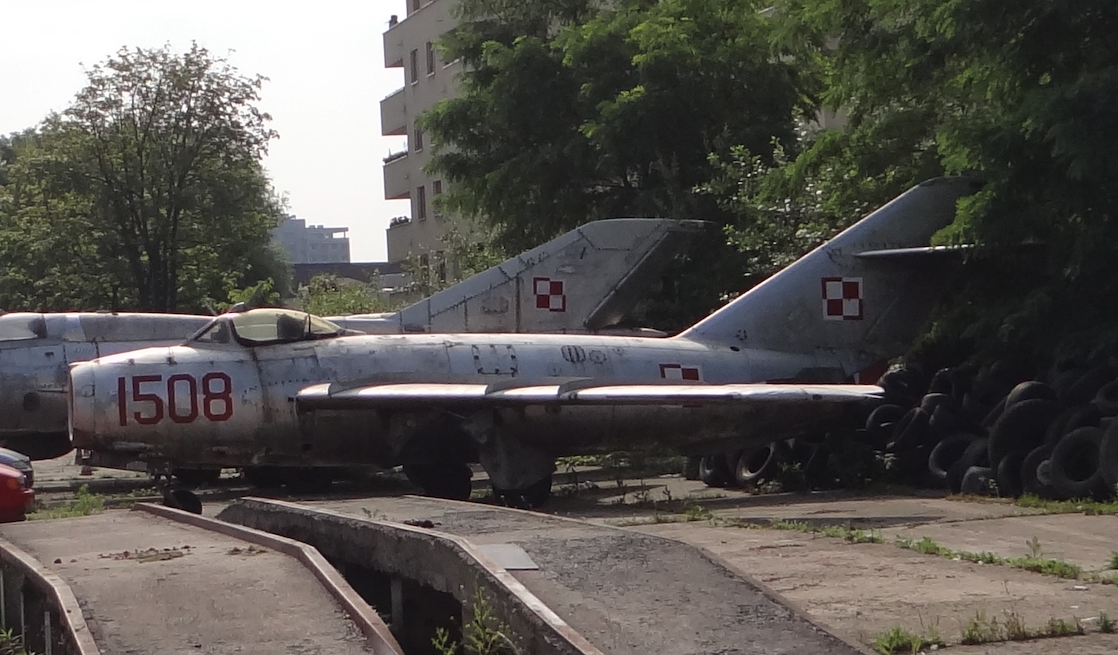
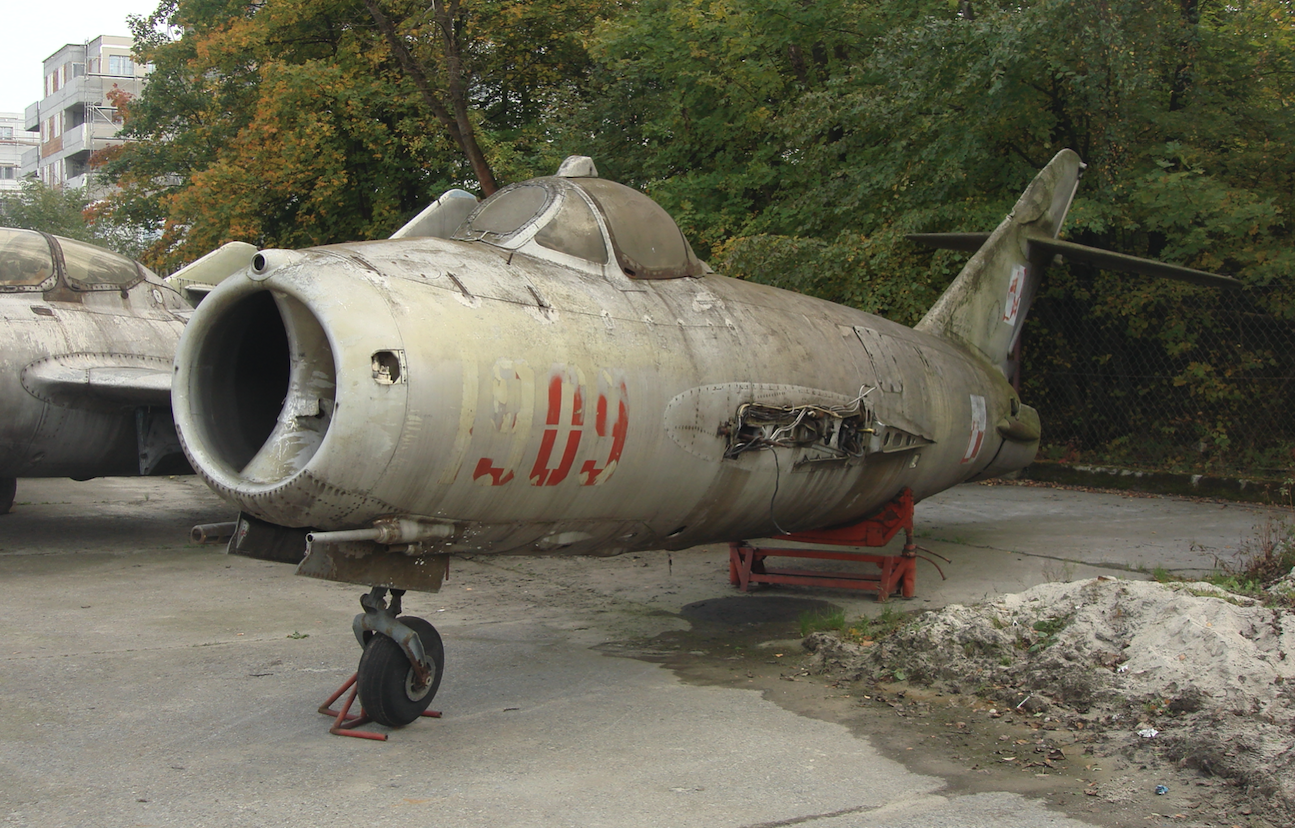
Lim-5
In 1956, Polish Fighter Aviation had: 541 fighters. All planes were turbojet powered; MiG-15, MiG-15bis, Lim-1, Lim-2 and MiG-17 PF. In 1956, we bought 4 MiG-17 F aircraft from CCCP, two of which served as a benchmark for mass production at PZL WSK-Mielec.
In 1955, a decision was made to start serial production of MiG-17 fighters at the WSK PZL Mielec factory. The Russians initially agreed to the production of the MiG-17 F version, i.e. without a radar sight. The version with the radar sight came in 1959.
At the beginning of 1956, preparations for the production of MiG-17 F aircraft under the designation Lim-5 began in WSK Mielec.
The first copy of Lim-5 with the factory number 1C 00-01 left the factory hall in Mielec on 1956-05-25, that is when the ordered Lim-2 aircraft were still being manufactured. The Lim-5 aircraft belonged to the trial batch consisting of three machines with numbers from 1C 00-01 to 1C 00-03. Machines have undergone factory and military tests. On 1956-11-28, the machines were handed over to the army and transported to the airport in Bemowo. It was five days after the last copy of the Lim-2 fighter plane was delivered to the army. The first copy of the Lim-5 aircraft numbered 1C 00-01 became the aircraft of the commander of the air forces. After years, he came to Dęblin as a study aid.
The airport in Bemowo (Babice) has become a place of training Polish pilots on Lim-5 planes. Further Lim-5 aircraft were delivered from the factory in 1957. One plane went to Dęblin. Also one to the Technical Institute for further flight tests.
By the spring of 1957, Lim-5 production was already well controlled. More planes were already in combat regiments. In total, throughout 1957, the army from the Mielec factory received 73 Lim-5 fighters. Adding to this 4 MiG-17 F machines and 12 MiG-17 PF machines previously imported from CCCP. In total there were 84 pieces. By the end of 1957, 222 fighters rolled off the assembly line in Mielec.
From February 8, 1957 to April 19, 1957, the first copy of the second production series 1C 02-01 passed the tests. This copy did not yet have an SRD-1 M radio-range meter, due to delays in delivery from CCCP. The aircraft was also heavier than the Soviet standard by 130 kg, presumably because subsequent changes have already been included in the Polish aircraft. This machine was not handed over to the army, it only served as a benchmark for serial production. In March 1958, the aircraft was transferred to the Institute of Aviation. At the Bemowo airport in Warsaw. The aircraft has passed all tests. The tests were completed in December 1959. Later, on this specimen, the AFA-39 camera was mounted under the middle of the fuselage, thus creating the Lim-5 R aircraft.
The production of Lim-5 aircraft was completed in 1960-06-30, after building 477 units, of which 120 fighters from 6, 7, 8 and 9 series were delivered to the GDR. The total production series was 19. The last produced on 1960-06-30, Lim-5 bears the designation 1C 19-14. The main production lasted 44 months, and the average production rate was 11 machines per month. It should be emphasized that the factory mastered the production of the aircraft and a good level of performance of all the copies.
The delivery of new aircraft to combat regiments resulted in machine rotation. The MiG-15, MiG-15 bis, Lim-1 and Lim-2 aircraft were gradually moved to assault aviation. It continued gradually from 1957 to 1960. The last two assault regiments from Mirosławiec and Inowrocław received jet aircraft in 1960. It was the end of the era of reciprocating aircraft in assault aviation.
The use of Lim-5 aircraft.
By 1960, approximately 357 Lim-5 aircraft had been armed with Polish fighter regiments. This aircraft became the basic fighter defending Polish Sky, but daytime fighter. The lack of radar sight meant that he was not a first-fighter. 12 MiG-17 PF aircraft gathered in the Independent Pursuit Squadron, adjacent to 1 PLM, played this role. At the same time, the MiG-19 P radar fighters and the MiG-19 PM radar and rocket radar fighter jets were introduced into our armament. The need to deploy more radar aircraft equipped with radar sights was inevitable.
Lim-5 aircraft were very important for the Polish Army. Many fighter pilots piloted these aircraft before they began piloting MiG-19 and MiG-21 fighters. However, in military history, Lim-5 planes are briefly described. We believe that this is wrong, and the plane should occupy a worthy place in history. In addition, the Lim-5 was the most-built fighter aircraft in Polish history.
Written by Karol Placha Hetman
Kraków 2007-05-01
140 Section 1956-05-25
WSK Mielec Lim-5
Poland
Construction
Fighter plane.

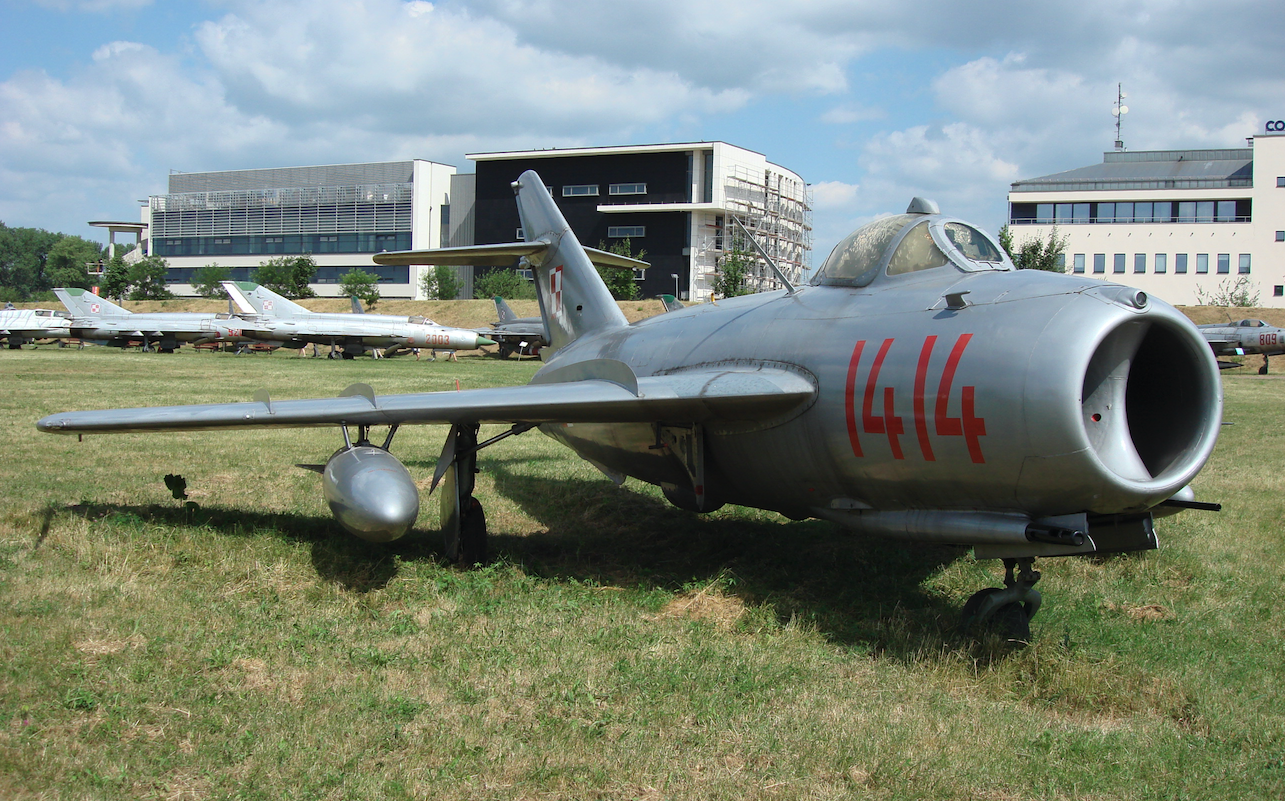
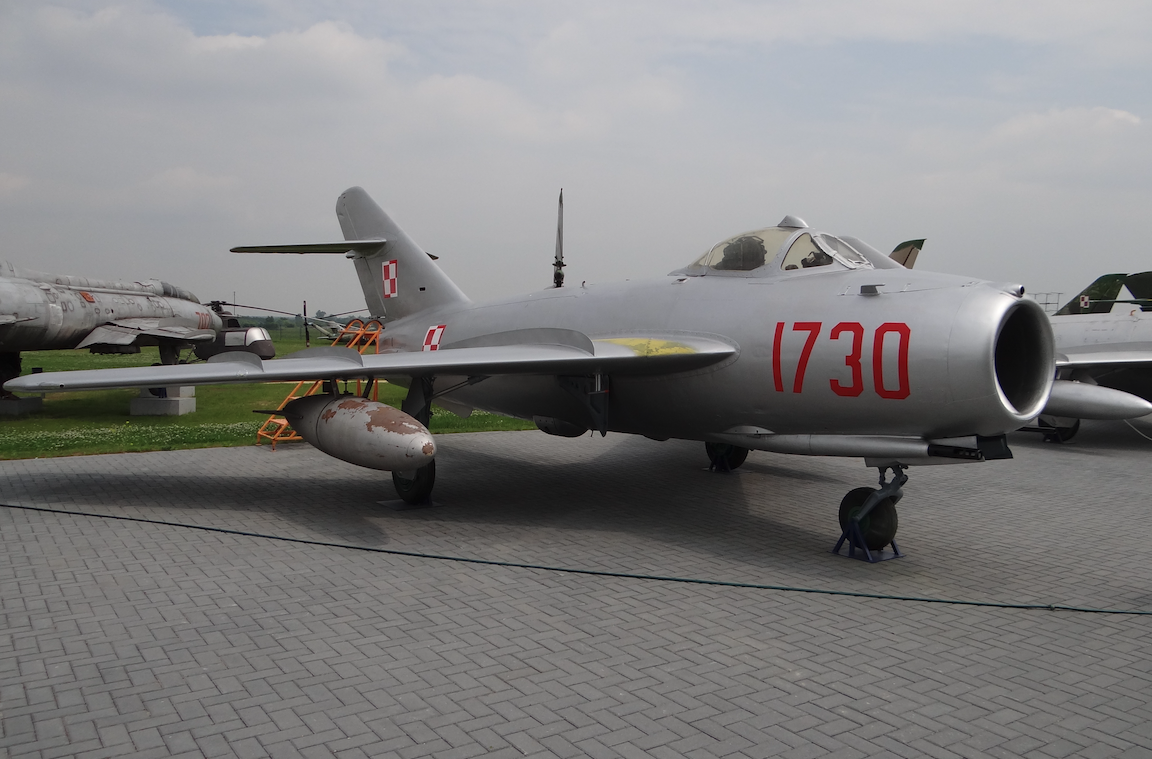
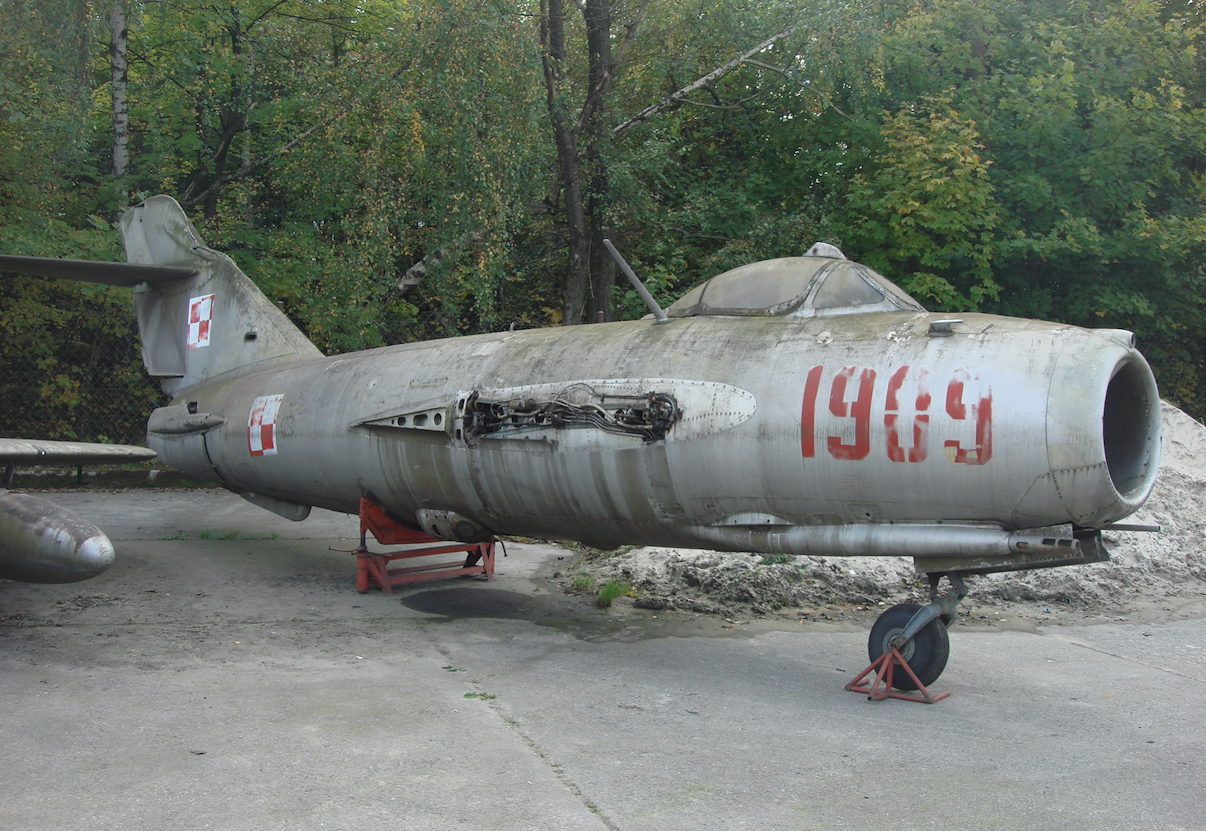
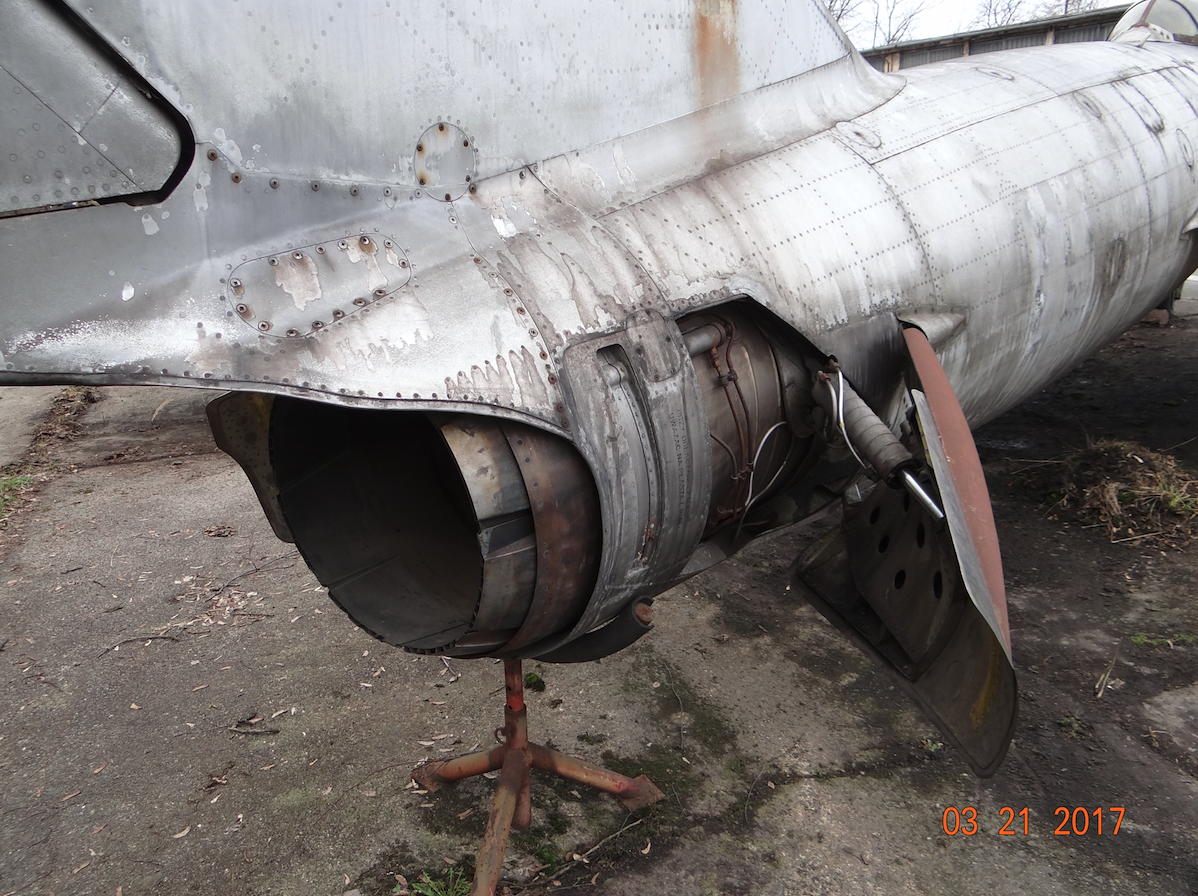
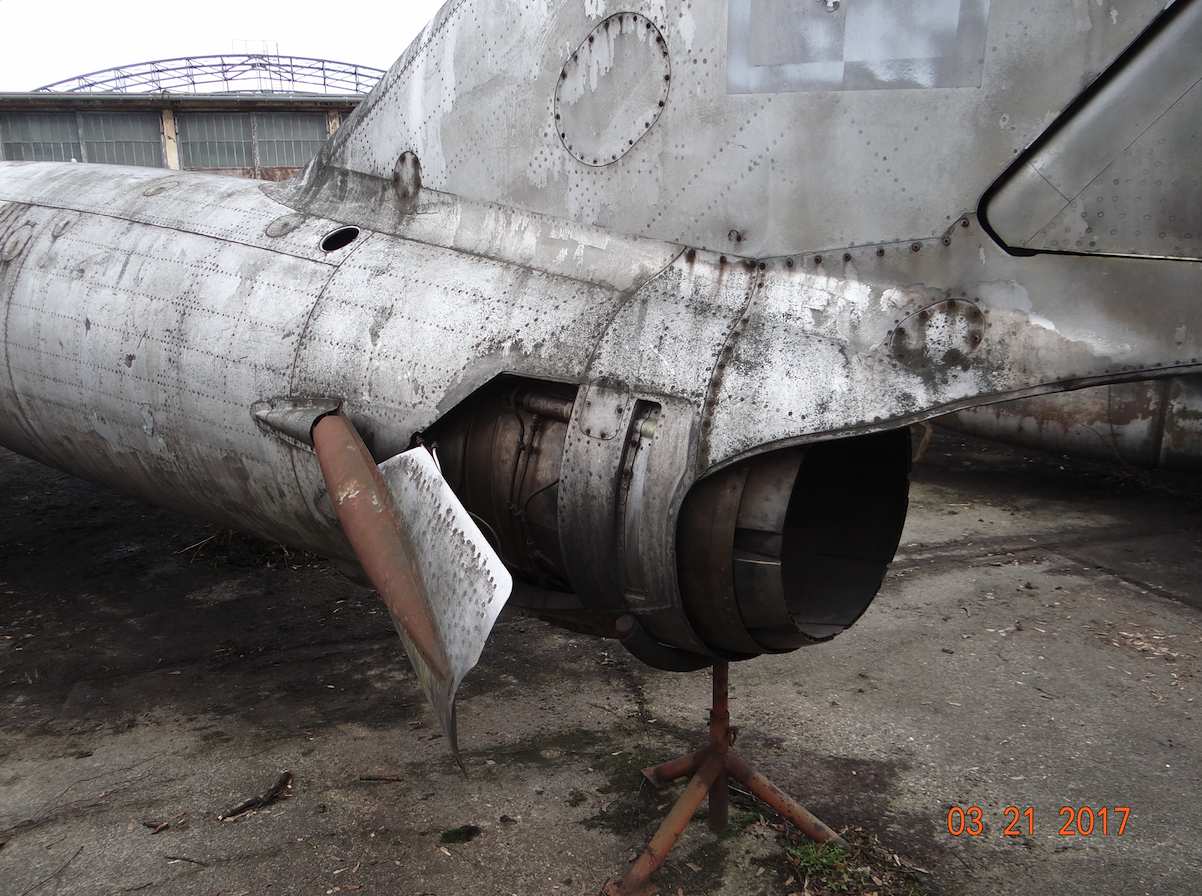
Construction Lim-5.
Single-engine, single-seat front fighter, built in a classic layout. Medium wing, with slanting wing. Half-shell construction, riveted.
An oblique wing, called a sickle wing, with a skew angle of 45 degrees at the fuselage and 42 degrees further. Laminar profile S-12s at the base and SR-11 at the end were used. The area of the wings is 22.6 m2, wedge angle 1 degree, elevation - 3 degrees, relative thickness 8%, elongation 4.08, convergence 1.23. Single girder design with rear auxiliary girder. 5.1 kg weight at the end of each wing. Flaps with a total area of 2.86 m2 swing out 20 degrees to take off and 60 degrees to land. Shuttlecocks with a total area of 1.6 m2 are tilted up and down by 18 degrees. The left aileron is fitted with a trimmer moved by an electric motor. On the upper surface of the panels three pairs of aerodynamic steering wheels. The wing is mounted to the hull with four knots.
The fuselage has a circular section technologically divided into two parts. The front part consists of 13 frames, the rear part of 18. The frame and the rear wing girder are mounted to frame 13. The maximum hull diameter is 1.45 m, the elongation is 6.17 m. The thickness of the coating varies from 1.5 to 1 mm. The air duct walls are 0.8 mm thick. Aerodynamic brakes with a total area of 0.98 m2, are pivoted by an angle of 55 degrees. The brakes are operated by a remote control, and additionally an automatic device that does not allow to exceed critical speeds. At Ma-0.97, the brakes open and close at Ma-0.92. Pilot's cabin partly armored from below. The glazing is a fixed front windscreen with a central armored window and a fairing retracted manually. A periscope at the top of the glazing to observe the rear zone. In the cabin, an overload protection system with PPK-1 garment and a chair thrown out with a face cover. Catapulting is allowed on flights over 250 m and up to a speed of 850 km / h.
Vertical fixture with an angle of 56 degrees, area of 4.26 m2, including 0.947 m2 of rudder. Swivel angle of 25 degrees. Horizontal fixture with an angle of 45 degrees, an area of 3.10 m2, including 0.884 m2 of rudders. Trimmer on the left helm. Headsets tilted 32 degrees up and 16 degrees down.
Front chassis with 480 x 200 wheel dimensions, main with 660 x 160 wheels. Chassis base 3.368 m, wheelbase 3.849 m.
Engine Lim-5.
The license Lim-5 and Lim-5 P built in Poland are powered by engines also produced under license by the Polish industry in WSK Rzeszów. It is a Lis-5 engine (license engine) with 1 x 26.46 kN (1 x 2 700 kG) thrust, and with post-combustion 1 x 33.12 kN (1 x 3 380 kG).
The afterburner is connected to the engine and constitutes an extended and properly formed outlet pipe. A set of injectors was placed there, through which additional fuel is supplied, and its combustion causes an increase in thrust. The afterburner is ended with an adjustable nozzle. The nozzle is fully open during the afterburner operation. When the afterburner is off, the moving segments close together reducing the cross-section of the outlet opening. The engine fuel is supplied by the PCR-1-5 pump.
The fuel was placed only in the hull, in the same way as in the Lim-1 / -2 fighter. The main soft fuel tank is located between the cab and the engine and has a capacity of 1,200 (1,250) liters. The second metal-type tank consists of two halves covering the engine at the rear of the hull. It has a capacity of 2 x 165 liters.
The internal fuel supply can be increased by using tanks suspended under the wings with a capacity of 2 x 400 liters. These tanks are made of duralumin sheet or plastic. There is a possibility of their drop during flight.
Armament Lim-5.
The armament of the aircraft was practically taken over from the MiG-15 fighter. It usually consists of one N-37 D (or similar) cannon with 40 cartridges and two NR-23 (or similar) guns with 80 cartridges for each parcel. There are also planes with fewer plots; e.g. 1 37 mm. and 1 cal. 23 mm. The plot assembly system was based on a tow truck dropped down.
The supplement is the S-13 photocarabine.
The permanent equipment of the aircraft is also the EKSR-46 electric helicopter mounted in a vertical stabilizer on the right, near its base. It has four signal rockets in different colors.
All versions have the ability to carry two bombs weighing from 2 x 50 kg to 2 x 250 kg. They are mounted with the use of D-4-50 ejector locks in place of additional fuel tanks.
Some machines are equipped as standard with the AFA-39 camera. the apparatus was placed in the lower half of the hull. It takes up to 200 photos from a height of 500 m to 5,000 m.
Data T-T WSK PZL Lim-5. 1956.
Span 9,628 m
Length 11.260 m
Height 3,800 m
Bearing area 22.60 m2
Curb weight 3 920 kg
Total weight 5 345 - 5 550 kg
Maximum weight 6,075 kg
Load weight 1 425 kg
Maximum speed of 1 097 km / h at 3 000 m
Top speed 1,145 km / h at 3,000 m with afterburner on
Climbing speed 65 m / s
Landing speed 180-200 km / h
Maximum range 1980 km
Flight time 2 hours 53 min
Ceiling 16 600 m
Run up 805 m
Run to stop 885 m
Lis-5 engine with 1 x 26.46 kN thrust without afterburning, 1 x 33.12 kN with afterburning
Crew 1 pilot
Number of copies 477.
Written by Karol Placha Hetman
Kraków 2020-02-15
Section 1956-05-25
WSK Mielec (LZR) MiG-17, Lim-5, Lim-6
Poland
Tally
In 1956, four MiG-17 F aircraft were bought. Two of them were used as a benchmark for serial production of Lim-5 aircraft at WSK PZL Mielec.
Lim-5. The first "zero" series, consisting of three Lim-5 aircraft. The aircraft were subjected to factory and military tests.
- Lim-5 No. 1C 00-01. The first flight on May 25, 1956.
- Lim-5 No. 1C 00-02.
- Lim-5 No. 1C 00-03.
Lim-5. The first production series consisting of 19 Lim-5 aircraft. The planes were built in the second half of 1956. They received numbers from 1C 01-01 to 1C 01-19.
- Lim-5 No. 1C 01-01 / 101. After serving, he came to the Fort Czerniakowski Museum. (1995).
Lim-5. The second production series consisting of 20 aircraft. The planes were built in the second half of 1956. They received numbers from 1C 02-01 to 1C 02-20.
- Lim-5 No. 1C 02-01 / 201. Built in 1956. The aircraft underwent tests from 1957-02-08 to 1957-04-19. The aircraft served as a production benchmark. In March 1958, the aircraft was transferred to the Institute of Aviation and transferred to the airport in Bemowo. Further tests were completed in December 1959. In 1960, the AFA-39 camera was mounted on this aircraft, thus creating the Lim-5 R aircraft.
- Lim-5 nr 1C 02-05 / 205. After serving, sent as teaching aid to the School in Zamość. Then set up as a monument in the Park in Zamość (2000). Then sold to a private collector.
Lim-5. The third production series consisting of 20 aircraft. The planes were built in the first half of 1957. They received numbers from 1C 03-01 to 1C 03-20.
- Lim-5 No. 1C 03-01 / 301. Used in 28 PLM in Słupsk. In 2003, he was still Słupsk, as an exhibit.
- Lim-5 nr 1C 03-05 / 305. After serving, it was sent to the Museum in Lublinek. In 2010, handed over to the Museum in Dęblin.
- Lim-5 nr 1C 03-09 / 309 - 5058. In 2002, set as a monument in Nowe Miasto nad Pilica with the fictitious number 5058.
Lim-5. The fourth production series consisting of 20 aircraft. The planes were built in the first half of 1957. They received numbers from 1C 04-01 to 1C 04-20.
- Lim-5 nr 1C 04-08 / 408. After serving, it was sent to the Museum in Lublinek. In 2010, handed over to the Museum in Dęblin.
- Lim-5 nr 1C 04-09 / 409. In 2004, he was in Miastko.
- Lim-5 No. 1C 04-15 / 415. Used in 2 PLM in Czyżyny. He remained in the Museum in Czyżyny.
- Lim-5 nr 1C 04-18 / 418. In 1996 sold to a private collector in the Netherlands.
Lim-5. The fifth production series consisting of 20 aircraft. The planes were built in the first half of 1957. They received numbers from 1C 05-01 to 1C 05-20.
- Lim-5 nr 1C 05-03 / 503. In 2005, after serving, he was in Bialystok.
- Lim-5 No. 1C 05-17 / 517. In 2004, private ownership in the town of Boguchwała.
Lim-5. In the second half of 1957, 120 Lim-5 aircraft were built for the GDR. The aircraft were built in four production series with the numbers: From 1C 06-01 to 1C 06-30, from 1C 07-01 to 1C 07-30, from 1C 08-01 to 1C 08-30, from 1C 09-01 to 1C 09 -30.
By the end of 1957, 222 Lim-5 machines were built, of which 77 were handed over to the Polish Army.
Lim-5. The tenth production series consisting of 30 aircraft. The aircraft were built in the first half of 1958. They received numbers from 1C 10-01 to 1C 10-30. The planes were modified.
- Lim-5 No. 1C 10-23 / 1023. In 2004, at the Museum in Czyżyny.
- Lim-5 No. 1C 10-30 / 1030, CM 10-30. The aircraft was converted into a stormtrooper. In 1957, transferred to the factory for the development of the assault version. CM 10-30 flown in 1959-07-02.
Lim-5. The eleventh production series consisting of 22 aircraft. The aircraft were built in the first half of 1958. They received numbers from 1C 11-01 to 1C 11-22.
Lim-5. The twelfth production series consisting of 26 aircraft. The planes were built in the second half of 1958. They received numbers from 1C 12-01 to 1C 12-26.
- Lim-5 No. 1C 12-17 / 1217. In 2005, an exhibit at the Museum in Warsaw.
- Lim-5 No. 1C 12-26 / 1226. In 2006, in Pułtusk.
Lim-5. The thirteenth production series of 27 aircraft. The planes were built in the second half of 1958. They received numbers from 1C 13-01 to 1C 13-27.
- Lim-5 nr 1C 13-02 / 1302. In 2005, an exhibit in Bydgoszcz.
- Lim-5 No. 1C 13-05 / 1305. In 1996, in Zamość.
- Lim-5 nb 1C 13-08 / 1308. From 2010 at the Museum in Dęblin.
- Lim-5 / Lim-5 R No. 1C 13-18 / 1318. In 1959, this aircraft was transferred to the Institute of Aviation. As the first Lim-5 was equipped with an AFA-39 camera placed in the fuselage. After serving as a monument in Miastko.
Lim-5. The fourteenth production series consisting of 26 aircraft. The planes were built in the first half of 1959. They received numbers from 1C 14-01 to 1C 14-26.
- Lim-5 No. 1C 14-09 / 1409. In 1997, in Nowa Sól.
- Lim-5 No. 1C 14-14 / 1414. In 1992, at the Museum in Czyżyny.
- Lim-5 nr 1C 14-19 / 1419. In 1995, as a monument in the Poznań Citadel, then at the Poznań Citadel Museum.
Lim-5. The fifteenth production series consisting of 27 aircraft. The planes were built in the first half of 1959. They received numbers from 1C 15-01 to 1C 15-27.
- Lim-5 No. 1C 15-01 / 1501. In 2000, at the Museum in Warsaw.
- Lim-5 No. 1C 15-08 / 1508. In 2004, at the Museum in Czyżyny.
Lim-5. The sixteenth production series consisting of 26 aircraft. The aircraft were built in the second half of 1959. They received numbers from 1C 16-01 to 1C 16-26.
- Lim-5 No. 1C 16-01 / 1601 stormtrooper. In 1959, left by the army in Mielec to develop an assault version.
- Lim-5 No. 1C 16-04 / 1604. In 2003, at the Museum in Warsaw.
- Lim-5 nr 1C 16-24 / 1624. The aircraft served in 34 PLM in Babich Doły. In 1980, it was still on active duty.
Lim-5. The seventeenth production series consisting of 25 aircraft. The aircraft were built in the second half of 1959. They received numbers from 1C 17-01 to 1C 17-25.
- Lim-5 No. 1C 17-12 / 1712. Rebuilt to the Lim-5 R version.
- Lim-5 No. 1C 17-17 / 1717. The aircraft operated at 45 PLM in Babimost. In 1996, presented in Modlin. Inscription on the fuselage; Last flight. On the tank, date - 12.07.1993.
- Lim-5 No. 1C 17-18 / 1718. The aircraft served in 45 PLM in Babimost. In 1985, it was in camouflage. Lim-5 No. 1C 17-21 / 1721. The aircraft served in 3/11 PLM in Strachowice. In 2004, as an exhibit in Drzonów. Lim-5 nr 1C 17-30 / 1730. After serving in 2010, it hit the Museum in Dęblin.
Lim-5. The eighteenth production series consisting of 30 aircraft. The planes were built in 1960. They received numbers from 1C 18-01 to 1C 18-30.
- Lim-5 No. 1C 18-30 / 1830. In 2002, as an exhibit in Sklęczki.
Lim-5. The nineteenth production series of 14 aircraft. The planes were built in 1960. They received numbers from 1C 19-01 to 1C 19-14.
- Lim-5 No. 1C 19-04 / 1904. In 1960, the army left this copy at the factory, as the third to work on the assault plane.
- Lim-5 nr 1C 19-09 / 1909. In 1995, he was sent to the Museum in Czyżyny.
- Lim-5 No. 1C 19-10 / 1910. In 2004, at the Museum in Czyżyny.
- Lim-5 No. 1C 19-14 / 1914 is the last copy of 477 built Lim-5 aircraft. The aircraft made its first flight on 1960-06-30.
477 Lim-5 aircraft were built in 19 production series and two subversions. The average production rate was 11 machines per month.
Written by Karol Placha Hetman
